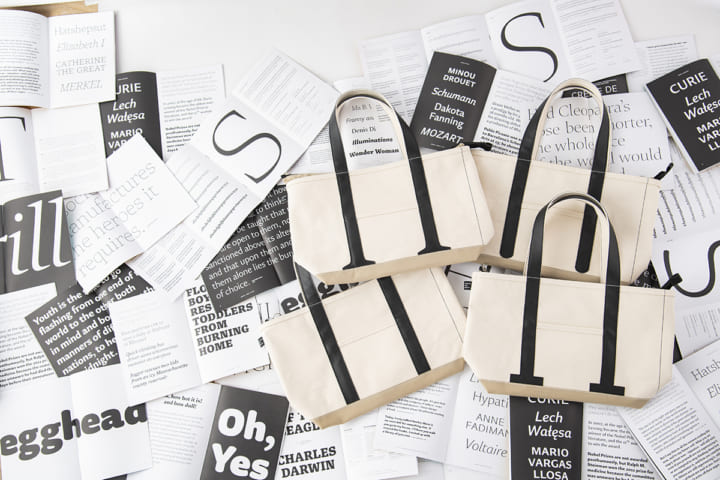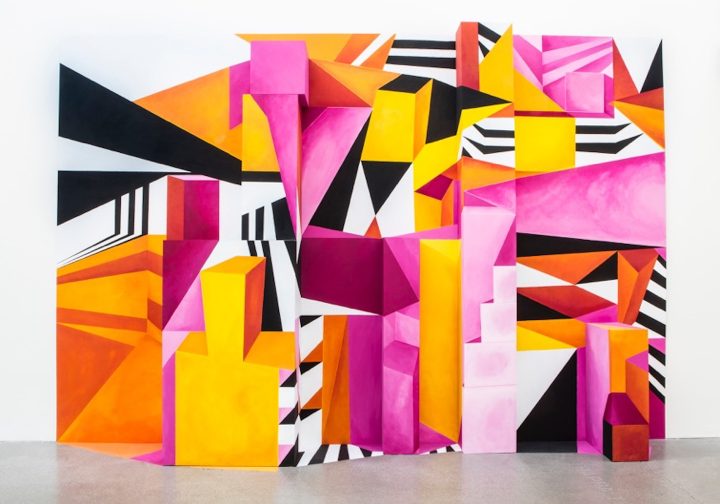PROMOTION | インテリア
2020.01.16 18:24
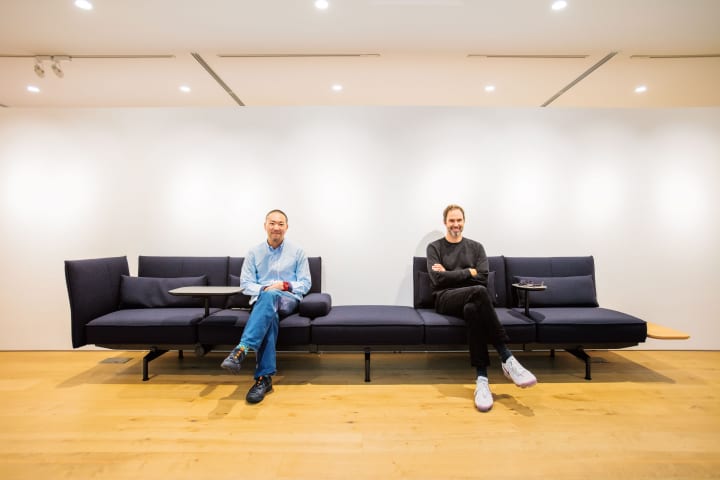
The English text follows the Japanese text.
2018年、ヴィトラから発表されたモジュラーソファシステム「ソフト ワーク」は、エドワード・バーバー&ジェイ・オズガビーによる新しいオフィスファニチャーだ。ワークスペースの新たな可能性に向き合うエドワード・バーバー。そして同じくプロダクトデザイナーであり、情報機器の面からワークスペースをみる森澤有人の対話から、これからのワークプレイスのあり方を探っていこう。
新しいワークスペースを家具から考える
コンピュータの発達、スマートフォンやクラウドコンピューティングの普及で、人々の働き方は大きく変化している。自由度が高まるとともにオフィス環境は変わり、世界のあらゆる場所がワークスペースと変貌した。そんな時代にオフィスや家具はどうあるべきか。スイスの家具メーカーであるヴィトラとデザイナーのエドワード・バーバー&ジェイ・オズガビーは、モジュラーソファシステム「ソフト ワーク」で、それに応えようと考えている。彼らはこれからのワークスペースをどのように捉え、ソフト ワークで何を実現しようとするのか。大手電機メーカーにシニアアートディレクターとして在籍する傍ら、個人としてもVAIOをはじめとする情報機器のデザインをディレクションする森澤有人とともに、バーバーに話を聞いた。
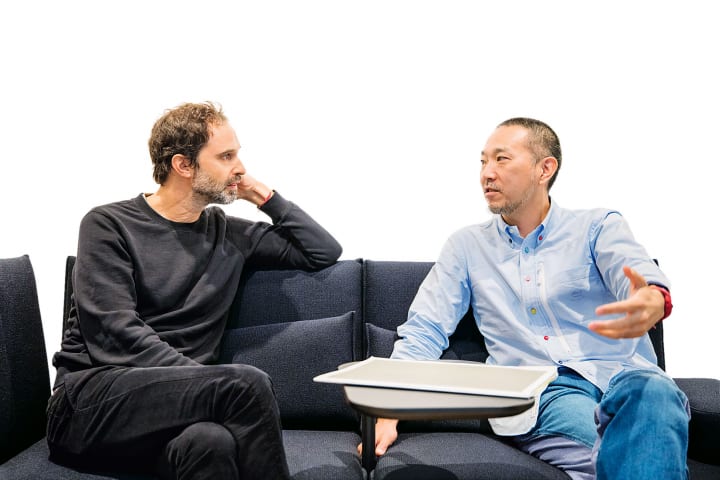
▲ソフトワークに座るバーバーと森澤。
求められるのは肩肘張らずに働ける環境
「2007年前後にワークスタイルが大きく変化したと思います。ラップトップ型コンピュータやスマートフォンの普及、そしてWi-Fi環境の整備で人々は場所に縛られず自由に働けるようになりました。同時に雇用形態も変化し、短期契約やフリーランスを選ぶ人が増えました。オフィスの他にもカフェやホテルのロビーがワークスペースの役割を担うようになり、コ・ワーキングスペースが普及します。現在のワーカーが望むものは何か。私たちは肩肘張らずに働ける環境だと考えます」と、バーバーは語り始めた。
人々が働く環境は常に進化している。働く場が工場からオフィスへと拡張されて以降、その環境は機器の発達とともに姿を変え続けている。こうした時代を見据え、ソフト ワークの開発が進められた。バーバーは、オズガビーとともに設計したエースホテル・ショーディッチにデザインのヒントがあったと振り返る。
「ロングテーブルやソファが並ぶラウンジはワークスペースとして人気ですが、ソファに屈んでコンピュータに向かう人々の姿に心を痛めていました。ソフト ワークではまず、コンピュータを使うには低すぎる座面の高さを見直すことから始めています。膝の上に置かれたコンピュータや床に散らばるコードを解決する、サイドテーブルや可動式のソケット、ワイヤレスチャージャー、スクリーンやクッション、照明などの付属アクセサリーを用意し、さまざまなシーンの創出を狙っています」。
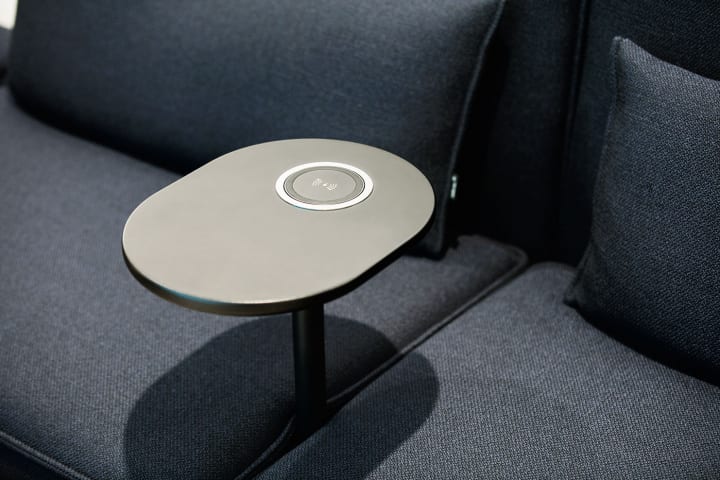
▲非接触型チャージャー。こうした進化の早いアクセサリーにも、次々と対応できるプラットフォームのようなソファシステムとなった。
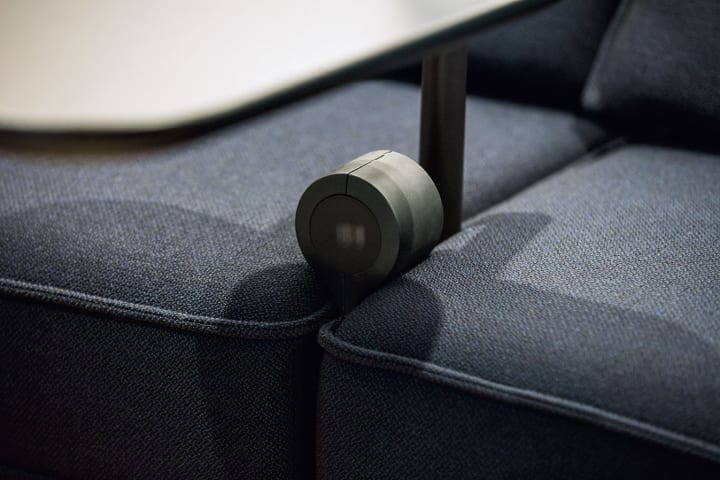
▲電源コンセントやテーブルなどユーザーに応じた可変性を持つソフト ワーク。電源コンセントは必要のないとき、ソファの下に収納できる。
それを受け、森澤は多様なパーツでソファの進化を促すアイデアに共感する。「インターフェースが進化し続け、さまざまな情報機器が普及することで、テーブルのサイズやアクセサリーの規格などパーツの変更も予想されますが、ソフト ワークならそれにも対応が可能でしょう。そのうちパーソナルコンピュータだったものがクルマや音楽のようにシェアの対象になると、アクセサリーにコンピュータそのものが含まれるのかもしれません。ソフト ワークは、進化し続ける家具となりそうです」。
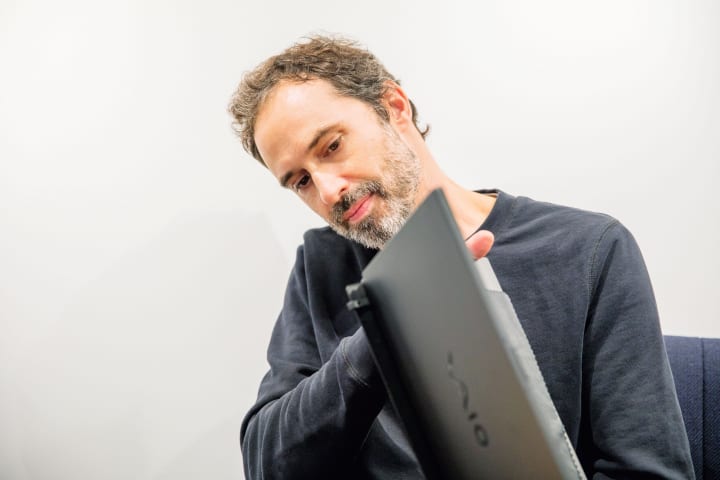
▲バーバーが手に取るのは使い方に応じた形状へと自在に変化できるVAIO A12 ALL BLACK EDITION。「スタビライザーフラップ」機構によって膝の上での作業も容易にしている。
“アジャイル“な働き方を提案する
さらに森澤は、新しい可能性を持つ家具ながら、ソフト ワークはスタンダードなソファの形状を踏襲している点にも注目。それはまるでオーダーメイドのスーツのようだと表現する。
「スーツにはルールがあり、着方そのものは変化しません。しかしオーダーによってディテールで遊び、カスタマイズすることができる。コンピュータも近い将来処理能力が飽和点に達し、大きな変化は望めないと言われています。キーボードも配列や打ち方は変化させず、人々の行動に適したスタンダードな形を実現しつつあります。開発すべきは形状を変えることではなく、心地よい使い勝手の実現です。ユーザーの望む形にさまざまな拡張性で応じるという点で、ソフト ワークはスーツやコンピュータなどと同じ進化を遂げていくのではないでしょうか」。
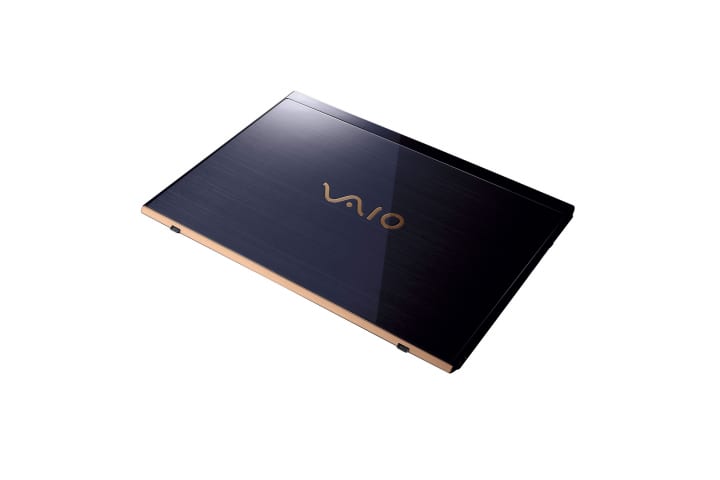
▲森澤がデザインしたVAIO SX14 (勝色特別仕様)。自然藍を含んだ染料を使った筐体は、一点一点が異なる色合いを持つ。
「ただ形の新奇性を追い求めては、製品があっという間に古びてしまいます。さまざまな機能と接続してフレキシブルな変化を実現することでソフト ワークは新しい可能性を追求したのです」と、バーバーはそれに応える。
またテクノロジーが進化する一方、人々の仕事はコンピュータやスマートフォンから離れた直接的な作業へ回帰する側面も増えているのではないかと森澤は持論を展開する。バーバーはそれを受け、自身はメールやプレゼンテーションを除いてコンピュータを使っておらず、人との対話こそ仕事に刺激を与えてくれるもので、ソフト ワークは個人のワークスペースであるとともにコミュニケーションの誘発も狙った家具であると話す。
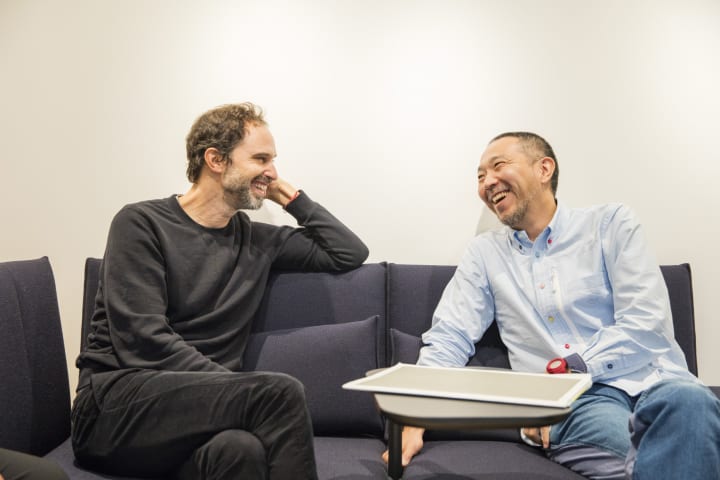
▲アクセサリーの進化によって、まだまだ可能性が広がると二人の話は盛り上がった。
「座面の高さはラップトップコンピュータでの作業を念頭に置きつつ、一方でソフト ワークと向き合うように置いた椅子に座る人と目が合う高さでもあります。私たちが以前デザインした椅子『ティプ トン』同様、家具を通じて“アジャイル“な働き方を提案しています。つまり、人々の行動や意識に迅速に応えられるものでありたい。時代はいつもテクノロジーとともにあり、テクノロジーで人々の行動は変化し、それを経て家具も変わっていくんです」。
ソフト ワークは私たちがよく知る家具の形を取りながら、ユーザーに新しい時間のあり方と出会いを生み出すプラットフォームだ。仕事は時に、その過酷な面が強調されるきらいがある。しかし本来は自身の創造性や他者とのコミュニケーションから生まれる刺激的な行為であり、論ずべきは、その環境のあり方なのだろう。柔軟な場を生み出すソフト ワークという家具は、仕事という時間が本来もつ豊かさに立ち返る新しい可能性を秘めている。そのしなやかさで、働くことの未来を変える大きな一手をヴィトラは打ち出したのだ。(文/山田泰巨 Text by Yoshinao Yamada 写真/井上佐由紀 Photos by Sayuki Inoue)![]()
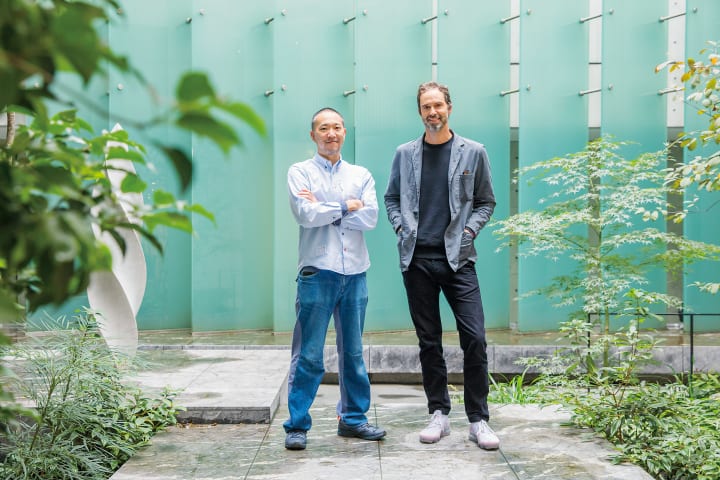
▲右 エドワード・バーバー/1969年生まれ。ロイヤル・カレッジ・オブ・アートで出会ったジェイ・オズガビーとともに96年バーバー&オズガビーを設立。家具、ロンドンオリンピックの聖火トーチ、エースホテルのインテリアなど、デザインからコンサルティングに至るまで多岐にわたる活動をしている。
Edward Barber was born in 1969. He established Barber Osgerby with Jay Osgerby whom he met while at the Royal College of Art in 1996. He has a multifaceted approach to design; from consultation to designing furniture, the London Olympic torch, and the interior for Ace Hotel London Shoreditch.
▲左 もりさわ・ゆうじん/1975年生まれ。98年フィラデルフィア芸術大学卒業。カリム・ラシッド・インクで、化粧品、家具、商業施設などをデザイン。2002年に帰国後、大手電機メーカーに入社。現在は、VAIOのデザインをはじめ、ベンチャー企業のクリエイティブサポートを行うなど、活動の幅はプロダクトデザインに留まらない。
Yujin Morisawa was born in 1975. He graduated from The University of the Arts, Philadelphia in 1998 and designed cosmetic products, furniture, and commercial facilities among others at Karim Rashid, Inc. He joined a major electric appliance manufacturer after returning to Japan in 2002. His current activities are not limited to product design, but range diversely including creative support for venture enterprises and doing design for VAIO.
The modular sofa system Soft Work released from Vitra in 2018 is a new office furniture item by Edward Barber & Jay Osgerby.
Here we present an exploration into the ideal form of workspace through a dialogue between Edward Barber, who explores new possibilities in workspaces, and Yujin Morisawa, who is also a product designer and views workspace from the perspective of information equipment.
Exploring new forms of workspace from furniture
The way people work has been changing greatly with the progress in computers and diffusion in smart-phones and cloud computing. All sorts of places around the world have been transformed into workspaces. How should offices and furniture exist in such an era? How will Swiss furniture maker Vitra and designers Edward Barber and Jay Osgerby interpret future workspaces and what are they trying to realize with the modular sofa system Soft Work? We interviewed Barber with Yujin Morisawa who directs design for information devices such as VAIO while belonging to a major electric appliance company as a senior art director.
A relaxing environment where people can work
Barber started off by saying, “I think work-styles changed drastically around 2007. With the diffusion of laptops and smart-phones as well as improvements in the wi-fi environment, people can work freely without being bound to where they are. At the same time, the format of employment has changed, and more people choose to have short-term contracts and become freelance workers. Other than just the office, places like cafés and hotel lobbies have taken on the role as workspaces, and co-working spaces have diffused. What do workers desire today? We think it’s an environment where they can work while being relaxed.”
Since the workplace has expanded from factories to offices, their environment has constantly been changing with the progress in devices. Barber says clues to his design dates back to when he designed Ace Hotel London Shoreditch with Osgerby. “Lounges are popular as workspaces, but I wasn’t comfortable seeing people facing the computer while hunched over on a sofa. With Soft Work, we started off by reexamining seat height that was too low for using the computer. To create various scenes geared for a comfortable working environment, we prepared a side-table and attachments including movable outlets and a wireless charger to solve the problems of having to place the laptop on one’s knee and having cords scattered on the floor.
In response to this, Morisawa empathized with the idea of promoting the evolution of the sofa with diverse parts. “As the interface advances, it is predicted that the size of the table and alterations in parts should be made, but with Soft Work, these can probably be dealt with. If what used to be a personal computer soon becomes something that can be shared like cars and music, the computer itself might be included among the accessories. Soft Work may become a piece of furniture that keeps evolving.
Proposing an “agile” way of working
Morisawa also takes note of the fact Soft Work adheres to the form of the standard sofa while possessing new possibilities. He describes it to be almost like a made-to-order suit. “There are rules with suits, and the way people wear them itself doesn’t change. But depending on the order, the tailor can play with details for customization. The processing capacity of the computer will also reach its saturation point in the near future, and it is said that major changes cannot be hoped for then. The arrangement of the keyboard and typing methods will not change, and its standard form that suits human behavior is about to be realized. What needs to be developed is not change in forms, but realization of ease-of-use that accompanies comfort. Soft Work will perhaps follow the same path of evolution as the tailored suits and computers.” To this, Barber responds, “However, simply pursuing novelty in form alone will make the product obsolete in a flash. We pursued new possibilities with Soft Work by enabling flexible changes by connecting it with various functions.”
Morisawa also explained his own theory that while technology advances, there may be increasing aspects in human work that will return to more direct processes that are removed from computers and smart-phones. In response to this, Barber says he himself does not use the computer other than for email or making presentations, and he gets stimulation from actual dialog with people, and Soft Work is a piece of furniture that provides a personal workspace for individuals while also aiming to induce communication.
“While the height of the seat envisions work with a laptop computer, it is also determined so that it matches the eye-level of a person sitting on a chair facing Soft Work. As with a chair called Tip Ton we previously designed, we’re proposing ‘agile’ ways of working through furniture. The times always move with technology, people’s behavior changes with technology, and furniture changes accordingly.”
Soft Work, while taking the form of furniture that is familiar to us all, is a platform that creates new ways of encountering and spending time with others. The harsh aspects of work tend to be emphasized at times, but in essence, it is a stimulating act born of one’s own creativity and communication with others, and what needs to be discussed may be the way its environment should be laid out. The piece of furniture called Soft Work that creates a flexible space provides its user with new possibilities to return to the richness that work intrinsically has. Through its flexibility, Vitra has introduced a new approach in changing the future of working.![]()






